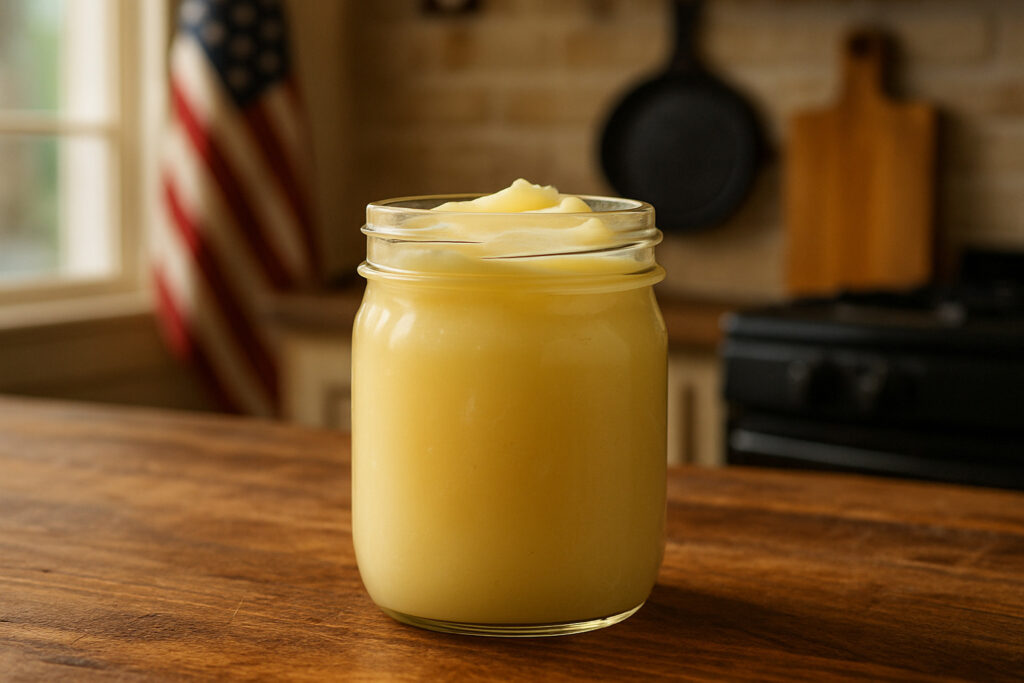Why Tallow Is Making a Culinary Comeback
Tallow is rendered beef or mutton fat that’s experiencing an unexpected renaissance in both kitchens and skincare routines worldwide. Once a staple in your grandparents’ cooking, this traditional fat disappeared from most homes over the past 70 years but is now trending again as food enthusiasts refind its unique properties.
Quick Facts About Tallow:
- What it is: Rendered fat from beef or sheep, solid at room temperature
- How it’s made: Slowly heating animal fat (suet) until it melts and clarifies
- Key properties: High smoke point (480°F), rich in vitamins A, D, E, and K
- Main uses: High-heat cooking, baking, skincare, soap making
- Nutritional profile: 52% monounsaturated fat, 42% saturated fat, 4% polyunsaturated fat
McDonald’s famously cooked their French fries in a mixture of 93% beef tallow and 7% cottonseed oil before 1990, giving them their legendary flavor and crispiness.
The modern tallow revival spans from high-end restaurant kitchens embracing nose-to-tail cooking to the viral #beeftallow TikTok trend with over 50,000 posts showcasing its skincare benefits. Food lovers are refinding tallow’s superior performance in deep frying and pastry making, while sustainability-minded cooks appreciate how it transforms food waste into a valuable ingredient.
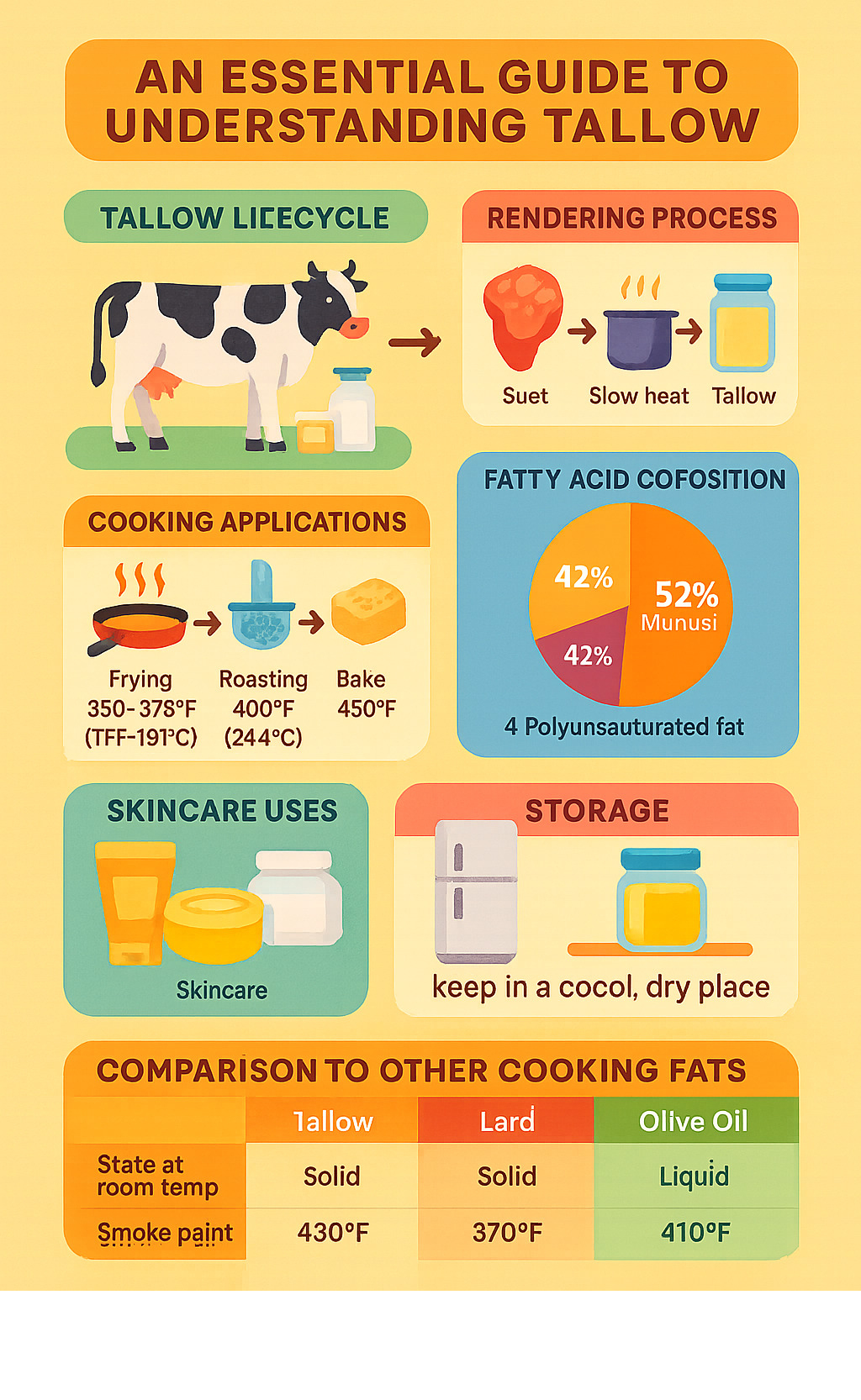
Basic tallow glossary:
Why This Guide Matters
Understanding tallow means grasping one of cooking’s most versatile and historically significant fats. This guide demystifies everything from its nutritional composition to modern applications, helping you make informed decisions about incorporating this traditional ingredient into your culinary trips.
What Is Tallow and How Is It Made?
Tallow starts as suet – the hard, white fat surrounding the kidneys and organs of cattle and sheep. When slowly heated, it transforms into liquid gold that cooks have treasured for centuries.
The rendering process is beautifully simple yet requires patience. As suet melts, it separates into pure liquid fat that becomes tallow, and crispy, protein-rich solids called greaves. These greaves aren’t waste – they’re a high-protein byproduct used for animal feed or fishing bait.
What makes tallow special is its unique composition of triglycerides, primarily from stearic and oleic acids. This gives it remarkable stability and an impressive smoke point of 480°F (249°C).
You can make tallow from both beef (most common) and mutton, though each has slightly different characteristics. There are two main rendering methods: dry rendering (using heat alone) and wet rendering (adding water to prevent burning).
Key Steps in Rendering Tallow
Making tallow at home connects you with generations of cooks who understood the value of using every part of an animal.
Start by cutting suet into small, uniform cubes – about one inch works perfectly. Place these pieces in a heavy-bottomed pot or slow cooker, keeping the temperature low and steady between 130-140°F.
Depending on the amount of fat, the process takes one to four hours. Stir occasionally, watching as the solid fat gradually melts into liquid and the greaves turn golden brown.
Strain the liquid fat through a fine mesh strainer, then through cheesecloth or coffee filters for crystal-clear results. As it cools, your liquid transforms into beautiful white, solid tallow that’s shelf-stable and ready to use.
Tallow vs Lard: Quick Comparison
Many people confuse tallow with lard, but these rendered fats have distinct personalities. Tallow comes from beef or mutton, while lard is rendered from pork fat. Tallow stays firmer at room temperature and offers a more pronounced, slightly savory taste.
The smoke point difference is significant: tallow’s 480°F versus lard’s 370°F means you can push temperatures higher without compromising flavor, making tallow the champion for deep frying and high-heat searing.
Types, Nutrition & Comparison to Other Fats
The world of tallow offers more variety than you might expect. Beef tallow dominates most kitchens, but mutton tallow from sheep and lamb tallow each bring their own personality. Mutton tallow tends to be firmer with more pronounced flavor, while lamb tallow offers a milder, almost sweet note.
Tallow is nutritionally impressive with 902 calories per 100 grams and fat-soluble vitamins A, D, E, and K. The cholesterol content sits at 109 mg per 100 grams, but tallow provides 2.25 to 3.8 times more energy per gram than corn, explaining why our ancestors relied on it for survival foods like pemmican.
The real magic happens when comparing tallow to other cooking fats. That 480°F smoke point puts it in the champion category, beating olive oil (375°F), butter (350°F), and coconut oil (350°F). Only refined avocado oil comes close at 520°F.
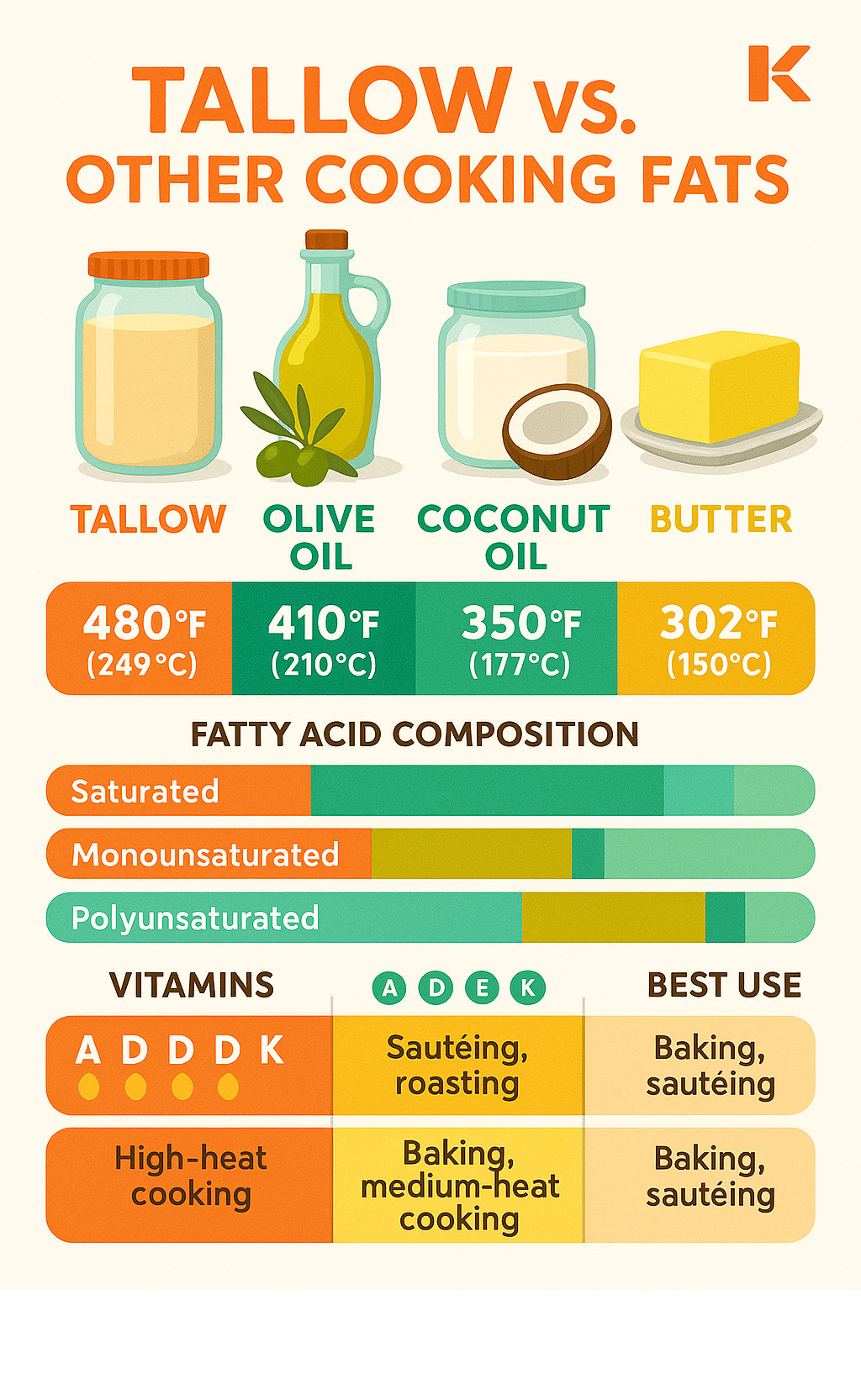
Scientific Snapshot
Tallow gets interesting from a nutrition science perspective. The fatty acid breakdown reads like a well-balanced portfolio rather than the saturated fat monster some people imagine.
Oleic acid makes up 47% of tallow’s composition – that’s the same monounsaturated fat that makes olive oil famous. Palmitic acid contributes 26%, providing structural stability. Stearic acid rounds out the major players at 14%, and research suggests stearic acid behaves differently from other saturated fats.
Scientific research on conjugated linoleic acid found in grass-fed tallow suggests potential anti-inflammatory and metabolic benefits, though more human studies are needed.
The takeaway? Tallow’s 52% monounsaturated fat content means it shares more characteristics with olive oil than most people realize.
Traditional & Modern Culinary Uses
Tallow transforms ordinary ingredients into extraordinary dishes. This ancient fat has earned its place back in modern kitchens because it performs better than many alternatives when you need serious heat and incredible flavor.
The secret lies in tallow’s impressive 480°F smoke point, which means you can push temperatures higher without that acrid, burnt taste. When deep frying potatoes or chicken, tallow creates gloriously crispy exteriors that stay crunchy long after they leave the oil.
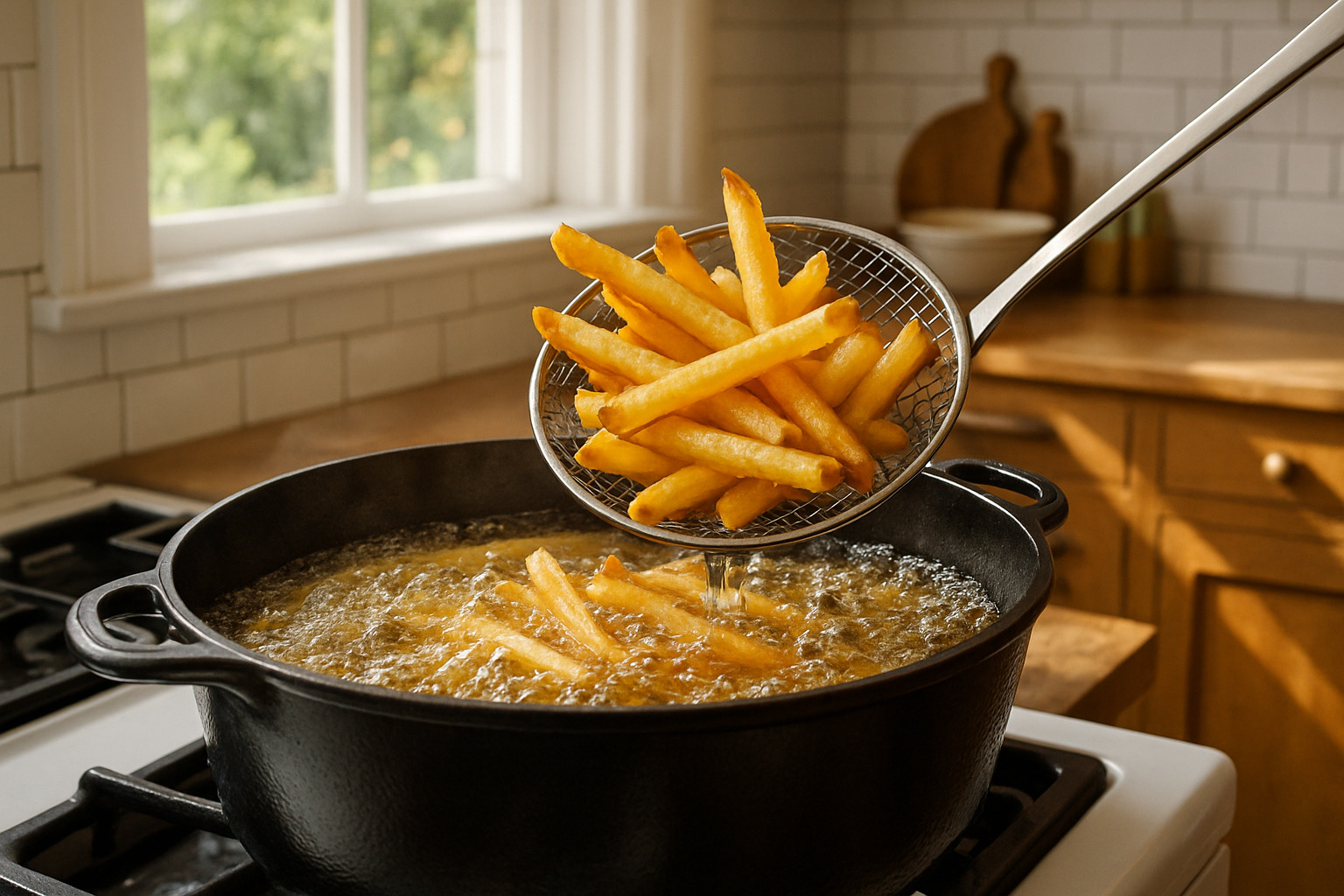
Modern chefs love tallow for roasting vegetables. Toss Brussels sprouts or carrots in melted tallow before hitting them with high oven heat, and you’ll get caramelization that makes people ask for your secret.
For baking enthusiasts, tallow works as exceptional pastry shortening, creating flaky, tender biscuits and pie crusts with subtle richness. Cast-iron lovers swear by tallow for seasoning their pans, as its stable composition builds beautiful, naturally non-stick surfaces.
Sourcing tallow locally connects perfectly with Why Locally Sourced Ingredients Make a Difference. When you know where your tallow comes from, you can trace the animal’s diet and living conditions.
Heritage Dishes Revived
Pemmican represents the ultimate survival food, combining rendered tallow with dried meat and berries into concentrated nutrition bars that could last for years. Yorkshire pudding demands screaming hot fat to create dramatic rise and crispy exterior – tallow’s high smoke point won’t burn at required temperatures. Traditional biscuits made with tallow develop flakiness and rich flavor that modern shortening can’t match.
Sustainable Dining with Tallow
Using tallow makes environmental sense because it transforms waste into something valuable. This philosophy aligns with the Sustainable Food Movement, where nose-to-tail cooking honors the animal by using every part thoughtfully. Tallow also offers an alternative to heavily processed industrial seed oils.
Tallow in Skincare & Cosmetics: Benefits, Evidence & Safety
The skincare world has gone wild for tallow. This rendered fat contains fatty acids that mirror what’s naturally found in human skin, making it an intriguing alternative to conventional moisturizers. The #beeftallow TikTok trend has exploded with over 50,000 posts of people claiming everything from miracle moisturization to eczema relief.
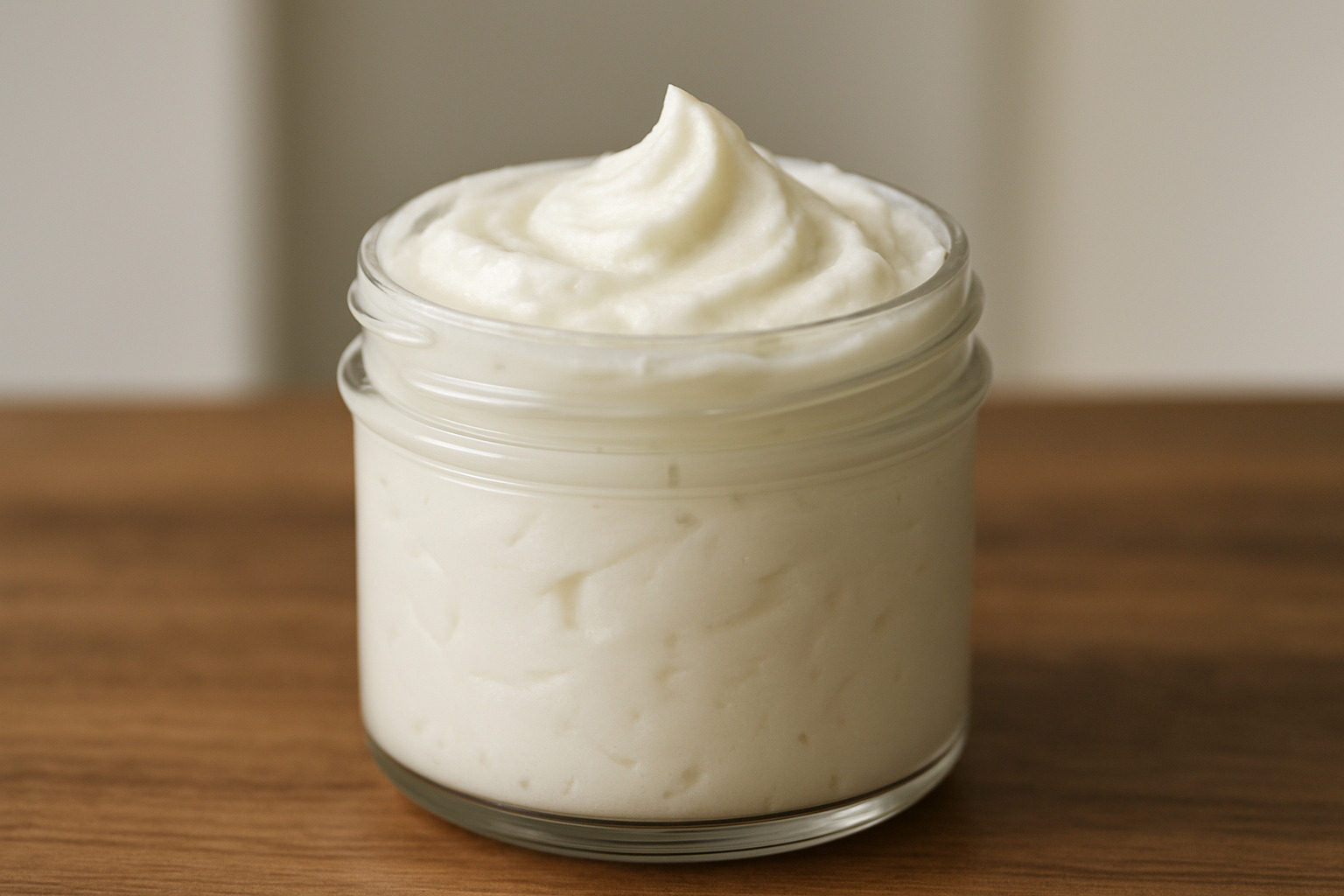
The science makes sense on paper. Tallow contains palmitic and stearic acids in proportions remarkably similar to human sebum – your skin’s natural oil. This fatty acid match theoretically helps support your skin’s barrier function and moisture retention. Plus, tallow acts as an occlusive moisturizer, creating a protective seal that prevents water from escaping your skin.
Proven & Anecdotal Benefits
Users consistently report deep moisturization that lasts, especially helpful for severely dry or cracked skin. The rich, occlusive nature seems particularly effective for harsh winter conditions. Many find tallow balms soothing for inflammatory conditions like eczema, though this falls into anecdotal territory. The natural ingredient appeal offers a single-ingredient moisturizer for people avoiding synthetic chemicals.
Potential Risks & Contraindications
Dermatologists want you to pump the brakes. Comedogenic concerns top the warning list – this rich fat can clog pores, especially if you’re prone to acne. Allergic reactions present another risk. If you’re allergic to beef, tallow skincare could trigger serious reactions.
Contamination risks multiply with DIY products or poorly processed versions. pH disruption often gets overlooked – tallow soaps typically clock in at pH 9-10, while healthy skin maintains slightly acidic pH of 5.4-5.9.
Patch-test any tallow product on your inner arm for 24-48 hours before applying to your face. If you have existing skin conditions, consult a dermatologist first.
Environmental, Ethical & Sustainability Considerations
When you think about sustainability, tallow tells a compelling story. This rendered fat transforms what would otherwise be waste into something valuable, which feels smart in our environmentally aware world.
The beauty of tallow lies in its role as an up-cycled by-product. When animals are processed for meat, rendering the fat means we’re honoring the whole animal rather than throwing parts away. This circular economy approach maximizes every resource and reduces environmental footprint per animal.
Grass-fed tallow takes sustainability further. Cattle that graze on pastures contribute to soil health through natural grazing patterns, and they need fewer industrial inputs. The tallow from these animals also packs better nutrition – improved omega-3 to omega-6 ratios and higher vitamin levels.
This connects with current Food Sustainability Trends, where traditional ingredients like tallow are being recognized as environmentally smarter choices than heavily processed alternatives.
Tallow even ventures beyond kitchen and bathroom. The U.S. Air Force has successfully tested aviation fuel blends containing 50% tallow-derived biofuel in C-17 aircraft.
Tallow vs Plant Oils in a Green Lens
Comparing tallow to plant oils isn’t straightforward. The environmental picture depends on production methods.
Land use presents fascinating trade-offs. Well-managed cattle grazing can improve soil health and help with carbon sequestration, while some plant oil crops like palm oil have driven deforestation. Processing is where tallow shines – it requires just heat and straining, while many plant oils go through chemical extraction and extensive refining.
The honest truth? Environmental impact comes down to production methods, scale, and local conditions rather than simply choosing animal or plant fats.
Storage, Handling & Popular Products
Keeping your tallow fresh requires attention to key storage principles. Think of tallow like butter – it needs protection from heat, light, and air to maintain quality and prevent rancidity.
Start with jar sterilization. Clean glass mason jars work perfectly for storing rendered tallow. Sterilize them with boiling water before filling to eliminate bacteria that could spoil your fat.
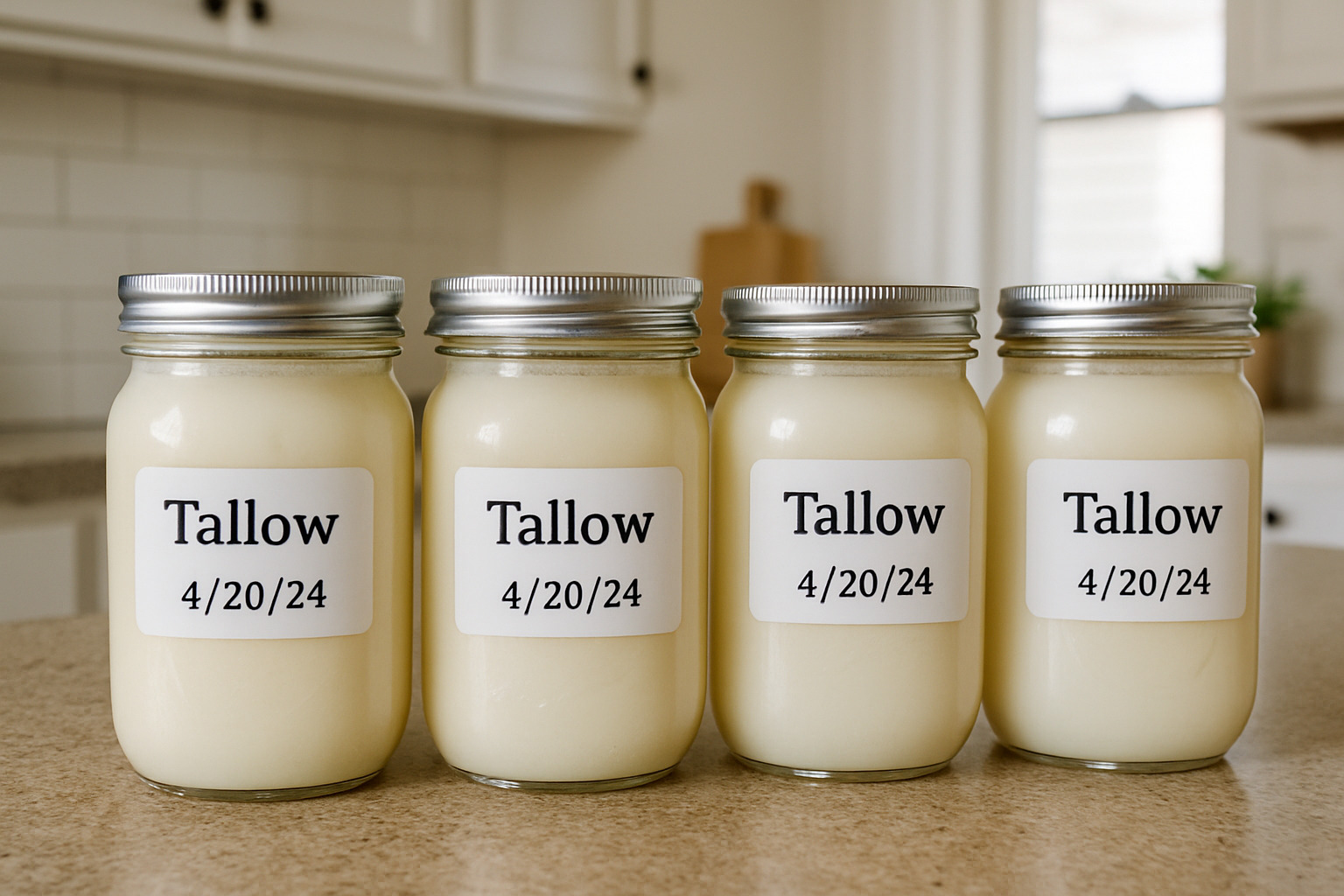
Cool, dark storage locations work best. A pantry shelf away from the stove, or better yet, your refrigerator, will keep it stable. The freezer offers incredible longevity – properly stored tallow can last 2+ years without losing quality when frozen.
Room temperature storage works for 3-6 months in sealed containers, while refrigerated tallow stays fresh for 6-12 months. Rancidity signs are usually obvious to your nose first. Fresh tallow smells mild and neutral – if you detect sour, fishy, or distinctly off odors, discard the batch.
The modern tallow market offers exciting variety, from simple cooking tubs sold by local farms to artisanal whipped balms for skincare. TikTok has boosted product availability significantly, with small producers selling directly through social media and farmers markets.
Safe Handling Checklist
Temperature control remains crucial – keep refrigerated until ready to use. Clean utensils and containers prevent contamination. Regular odor checks catch problems early. Transparent sourcing matters – choose suppliers who can tell you about the animals’ diet and processing methods. For skincare applications, patch testing prevents unpleasant reactions.
Frequently Asked Questions about Tallow
What differentiates beef and mutton tallow nutritionally?
The nutritional differences are surprisingly subtle. Both deliver 902 calories per 100 grams and provide similar levels of fat-soluble vitamins A, D, E, and K. Mutton tallow typically contains slightly higher saturated fat levels and often carries more pronounced flavor compared to beef tallow’s neutral taste.
The most significant nutritional difference comes from the animal’s diet rather than species. Grass-fed versions of both contain better omega-3 fatty acid profiles and higher vitamin concentrations compared to grain-fed alternatives.
Is using tallow safe for acne-prone skin?
This sits at the heart of the #beeftallow skincare debate. Tallow presents a complex situation for acne-prone skin without a simple answer.
The main concern is tallow’s comedogenic properties – its rich fat content can potentially clog pores and worsen breakouts, especially for people with naturally oily skin. However, some individuals report that tallow’s anti-inflammatory properties actually help calm their acne.
The safest approach involves patch-testing on a small area first and consulting with a dermatologist before making tallow part of your skincare routine.
How long does rendered tallow last at room temperature?
Properly rendered tallow offers impressive shelf stability. At room temperature, tallow stays fresh for 3-6 months when stored in sealed containers away from heat and direct light.
Refrigeration extends storage to 6-12 months, while freezing can preserve quality for 2+ years. Watch for warning signs: rancid or sour odors, color changes from white to yellow or gray, and any mold growth. Always use clean utensils when scooping to prevent introducing bacteria.
Conclusion
Tallow bridges the gap between our culinary past and sustainable future in ways that continue to surprise food lovers and wellness enthusiasts. This humble rendered fat has proven that sometimes the old ways really were better – at least when it comes to achieving perfect French fries and deeply nourishing skincare.
Throughout this guide, we’ve explored how tallow delivers exceptional performance in high-heat cooking, offers intriguing possibilities for natural beauty routines, and supports sustainable food practices. Its 480°F smoke point makes it a champion for deep frying, while its fatty acid profile closely matching human skin has sparked a genuine skincare revolution.
The balanced perspective matters most. Tallow isn’t perfect for everyone or every situation. Those with acne-prone skin should approach cautiously, and proper storage and sourcing understanding benefits everyone. But for people seeking minimally processed, traditional alternatives to industrial oils and synthetic skincare ingredients, tallow offers compelling benefits backed by both historical use and emerging research.
What makes tallow particularly exciting is how it embodies circular economy principles driving modern sustainable dining. By changing waste into valuable cooking fat and skincare ingredients, we honor both animals and our environment while accessing superior culinary results.
The renaissance of tallow reflects a broader movement toward understanding our food sources, reducing waste, and reconnecting with traditional wisdom. Whether you’re rendering your own fat from local grass-fed cattle or trying your first tallow-based face balm, you’re participating in a food story that spans generations.
Ready to explore more connections between traditional foods and modern sustainability? Find our Farm-to-Table Dining Experiences – your next culinary trip starts here!

